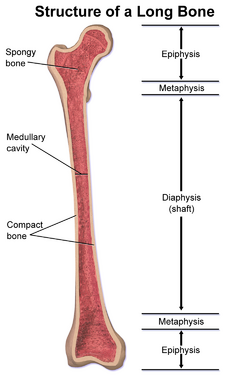Epiphysis facts for kids
Quick facts for kids Epiphysis |
|
|---|---|
 |
|
| Structure of a long bone, with epiphysis labeled at top and bottom. |
An epiphysis (say: eh-PIF-ih-sis) is the rounded end or tip of a long bone. Think of it as the cap on each end of a long bone, like your thigh bone or arm bone. These ends grow from a special spot called a secondary center of ossification.
Right between the epiphysis and the main, long part of the bone (called the diaphysis), you'll find the metaphysis. This area includes the epiphyseal plate, which is also known as the growth plate. This plate is super important because it's where your bones grow longer!
At a joint, the epiphysis is covered with smooth articular cartilage. This cartilage helps bones slide past each other easily. Below this covering is a special bone area called subchondral bone. You'll only find epiphyses in mammals, which means it's a special feature of mammals.
The epiphysis is full of red bone marrow. This amazing marrow is like a factory that makes red blood cells, which carry oxygen all over your body!
Contents
Types of Epiphysis
There are four main types of epiphyses in your body. Each type has a different job or a special way it connects to other parts of your skeleton.
Pressure Epiphysis
- What it is: This type of epiphysis is found at the ends of long bones that form a joint. They are called "pressure" epiphyses because they help carry the weight of your body.
- How it works: When you move, walk, or run, these parts of your bones are under pressure. They help transfer your body's weight from one bone to another.
- Examples: The top part of your femur (thigh bone) that connects to your hip is a pressure epiphysis. The top of your humerus (upper arm bone) that forms your shoulder joint is another example. Also, the rounded ends of your femur and tibia (shin bone) at your knee joint are pressure epiphyses.
Traction Epiphysis
- What it is: Unlike pressure epiphyses, these parts of the long bone are not directly involved in forming a joint. They don't help carry your body's weight.
- How it works: Even though they aren't part of a joint, they are usually close to joints. This is where strong ligaments and tendons attach to the bone. Ligaments connect bones to bones, and tendons connect muscles to bones.
- When they grow: Traction epiphyses usually harden into bone a bit later than pressure epiphyses.
- Examples: The bumps on your humerus (like the greater and lesser tubercles) and the bumps on your femur (like the greater and lesser trochanters) are examples of traction epiphyses. Muscles attach to these bumps to help you move your arms and legs.
Atavistic Epiphysis
- What it is: This is a special kind of bone that used to be a separate bone in our ancestors (like four-legged animals). But in humans, it has fused, or joined, with another bone.
- Examples: The coracoid process of your scapula (shoulder blade) is an atavistic epiphysis. In some animals, this part is a separate bone, but in humans, it's part of the shoulder blade. Another example is the os trigonum, a small bone sometimes found at the back of the talus (an ankle bone).
Aberrant Epiphysis
- What it is: These epiphyses are not always present in everyone. They are like extra or unusual growth centers that can sometimes appear.
- Examples: Sometimes, an epiphysis might be found at the head of your first metacarpal bone (the bone connecting your thumb to your wrist). You might also find them at the base of other metacarpal bones in your hand.
Bones with an Epiphysis
Many of the long bones in your body have epiphyses at their ends. Here are some of them:
- Humerus: This is your upper arm bone, found between your shoulder and elbow.
- Radius: One of the two bones in your forearm, located below the elbow. It's on the thumb side of your arm.
- Ulna: The other bone in your forearm, also below the elbow. It's on the pinky finger side of your arm.
- Metacarpals: These are the long bones in the palm of your hand. They connect your wrist bones to your finger bones.
- Phalanges: These are the bones that make up your fingers and toes.
- Femur: This is your thigh bone, located between your hip and knee. It's the longest and strongest bone in the human body!
- Fibula: One of the two bones in your lower leg. It's smaller and runs alongside your shin bone (tibia).
- Tibia: This is your shin bone, the larger of the two bones in your lower leg. It carries most of your body's weight.
- Metatarsals: These are the long bones in the middle of your foot. They connect your ankle bones to your toe bones.
Additional images




